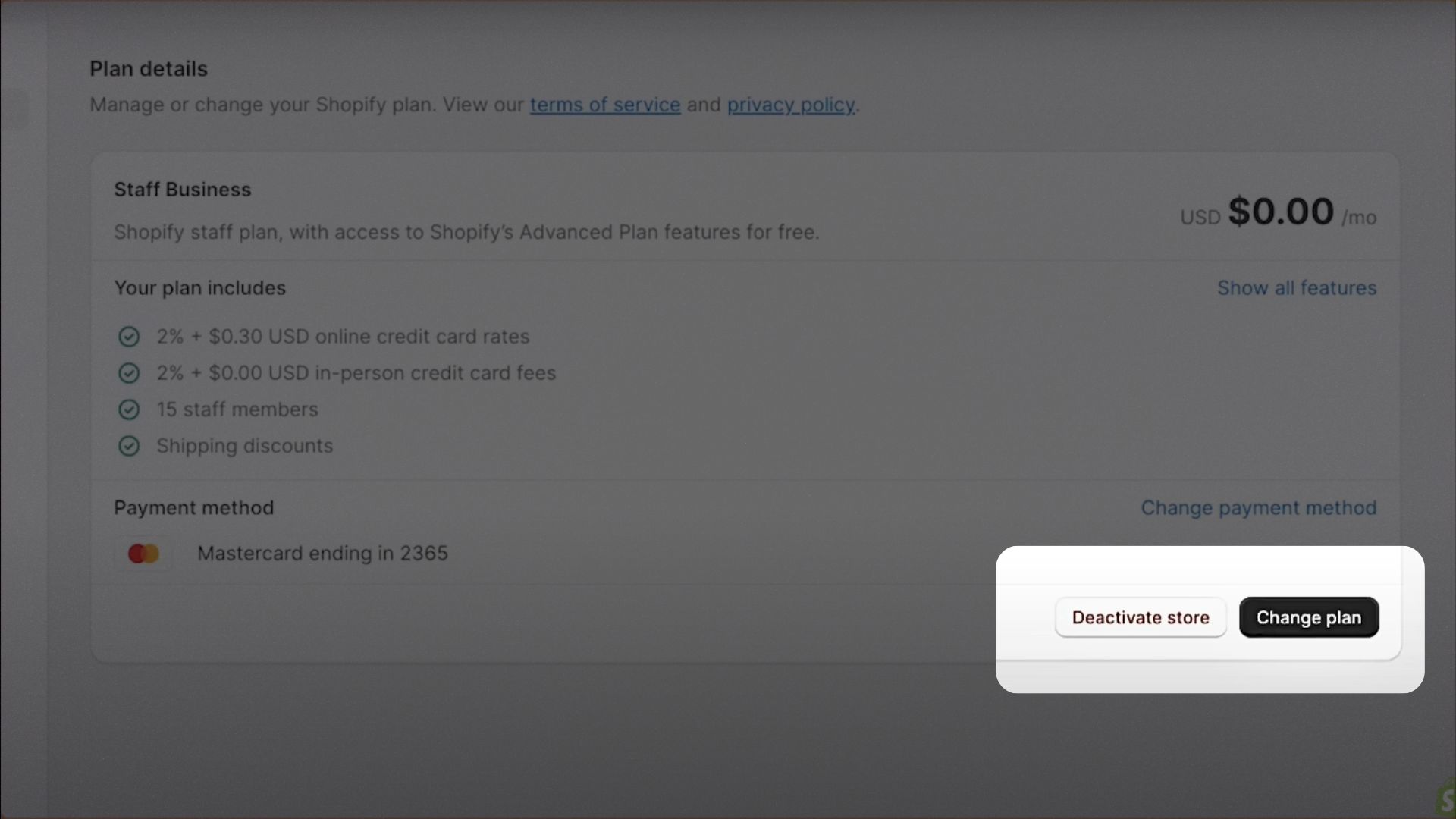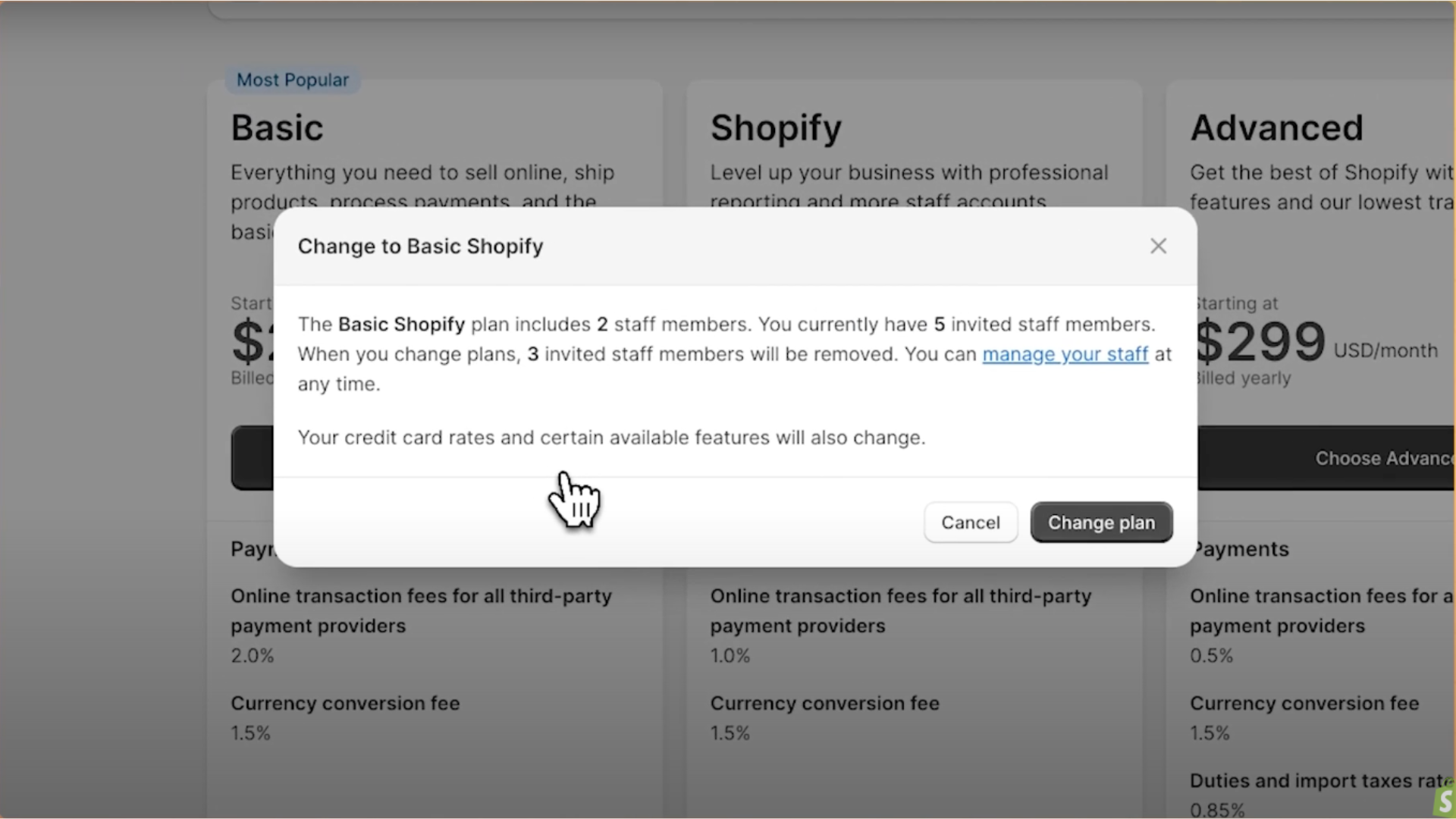How to Change Your Shopify Plan? Quick Guide for 2025

Table Of Contents
Changing your Shopify plan is a pivotal decision for e-commerce entrepreneurs looking to align their platform capabilities with their business needs. Understanding the process is crucial, whether scaling up for increased traffic or optimizing costs during lean periods.
You may easily modify your Shopify plan by following the instructions in this brief guide. From evaluating your requirements to navigating the Shopify dashboard, you will gain insights into optimizing your e-commerce operations. Let's dive in and ensure your Shopify plan aligns perfectly with your business objectives.
Why Should You Consider Changing Your Shopify Plan?

Assessing Your Current Needs
Changing your Shopify plan can significantly impact the efficiency and effectiveness of your e-commerce operations. The first step in the process is to evaluate your present needs thoroughly. Spend time carefully reviewing the features, functionality, and any limitations your current Shopify subscription may have on your company. Identify any limitations or excesses in your current plan, such as capped features, storage limits, or higher-than-necessary pricing tiers.
Additionally, consider your business's future growth trajectory and evolving requirements. Anticipating factors like increased sales volume, product expansion, or international expansion plans will help ensure that your chosen plan can scale alongside your business.
Understanding Shopify Plan Options
Once you've assessed your current situation and aspirations, understand the available Shopify plan options. Shopify has various plans catering to various business sizes and requirements, including Basic, Shopify, and Advanced levels. Every plan has unique features, restrictions, and cost factors.
Take the time to compare the features and pricing of each plan, considering factors such as transaction fees, access to advanced features like abandoned cart recovery or gift cards, and scalability options. By gaining a comprehensive understanding of the available Shopify plans, you can make an informed decision that optimizes your e-commerce operations and effectively supports your business growth.
You can read more details and specifics about the Shopify packages below for the most accurate choice:
Steps to Change Your Shopify Plan
Step 1: Access Your Shopify Account
Log in to your Shopify account using your credentials.

Step 2: Navigate to the Plan Section
Once logged in, locate and click the "Settings" option in the bottom left corner of the dashboard. From the Settings menu, select "Plan".


Step 3: Change Your Plan
There you will see all the details about the plan you are currently on. To make a change, click "Change plan".

Step 4: Select Your New Plan
Here you will see all the plans you can choose from. When you have decided, pick a plan as in this image click "Choose Basic", "Choose Shopify" or "Choose Advanced".

Step 5: Confirm to Change Your Plan
If you are already on a paid plan, you will see a pop-up window with high-level details of what this plan offers. If you are on a free trial, you will skip this pop-up and automatically be sent to the next page. Click "Change plan."

Step 6: Choose the Billing Cycle
On the next page, choose whether to pay monthly or yearly. Then click "Confirm billing cycle".

Step 7: Complete to Change Your Plan
Now, click "Subscribe".

Step 8: Review Plan Change Confirmation
Once the payment process is complete, Shopify will display a confirmation message confirming the successful change of your Shopify plan. You'll also receive an email confirmation of the plan change.
Best Practices and Tips

Timing Considerations for Plan Changes
Timing your Shopify plan change is critical to minimize disruptions to your business operations. Avoid changing your plan during peak sales periods or times of high website traffic. This includes holidays, promotional events, or product launches. Making changes during these times could impact your website's performance and potentially lead to lost sales.
Additionally, evaluate your business cycle to identify periods of relative calm or lower activity. Aim to schedule the plan change during these times to reduce the Impact on your day-to-day operations.
Plan the change well in advance to allow for any necessary preparations or adjustments. Notify your team members, especially those involved in managing the website, to ensure everyone is aware of the upcoming changes.
About the billing cycle, consider your current billing cycle and when it's most convenient to initiate the plan change. Coordinate with Shopify to ensure a seamless transition between billing periods.
Communicating with Shopify Support If Needed

(Source: Shopify help center)
Contact Shopify's support staff without delay if you run into any difficulties or have any particular queries about the plan change procedure. In your help request, be sure to state your queries or concerns clearly. Include relevant information such as your store URL, current plan details, and any specific issues you're experiencing.
Be Patient! Understand that support agents may be assisting multiple users simultaneously. Be patient and allow them time to address your inquiries thoroughly. If you don't receive a response or resolution within a reasonable timeframe, don't hesitate to follow up with Shopify support. Politely remind them of your query and request an update on the status of your issue.
Utilizing Trial Periods Effectively

Shopify gives you the opportunity to test out their programs during trial periods so you can decide what you want to modify before committing. Make use of this time to try out the features and capabilities of various plans. Test the usefulness of solutions like marketing automation, abandoned cart recovery, and sophisticated analytics for your company.
It is necessary to monitor your website's performance during the trial period. Pay attention to factors such as page load times, checkout process efficiency, and mobile responsiveness to assess the Impact of each plan on user experience.
And also, solicit feedback from your team members or trusted advisors during the trial period. Their insights can provide valuable perspectives on which plan best aligns with your business objectives.
Read more:
Shopify Free Trial: Empower Your Online Venture Today!
Planning for Future Scalability

When changing your Shopify plan, it's essential to consider your future scalability and growth potential. Assess the scalability of each plan by evaluating its features and capabilities. Consider aspects such as product inventory limits, bandwidth restrictions, and scalability of marketing tools to accommodate future expansion.
For business projections, review your business projections and growth forecasts to anticipate future resource needs. Choose a plan that offers sufficient scalability to support your projected growth trajectory without requiring frequent plan upgrades.
Considering the Plan's Flexibility, opt for a plan that provides flexibility to adjust as your business evolves. In order to adapt your plan to changing demands without having to pay large fees or experiencing major disruptions, look for choices that let you do so with ease.
What Happens to Your Store When You Change Your Shopify Plan?

When you change your Shopify plan, several things happen to your store to accommodate the new plan:
Access to Features: Your access to features and functionalities may change based on the new plan you select. Higher-tier plans typically offer more advanced features, such as advanced analytics, abandoned cart recovery, and gift cards. Conversely, downgrading your plan may result in the loss of certain features.
Resource Limits: Each Shopify plan comes with resource limits such as product listings, file storage, and staff accounts. Upgrading your plan may increase these limits, allowing you to expand your store's offerings and scale your business more effectively. Conversely, downgrading may require you to adjust your store's configurations to stay within the new limits.
Billing Changes: Your billing details will be adjusted to reflect the pricing and billing cycle of the new plan. Depending on the timing of the plan change, you may receive a prorated credit or charge to account for the difference in plan costs.
Trial Period: If you're switching to a higher-tier plan or trying out a new plan for the first time, you may have access to a trial period. During this time, you can explore the features and functionalities of the new plan before committing to it fully.
Store Settings: Your store settings, configurations, and customizations will remain intact after changing your Shopify plan. However, certain features or settings specific to your previous plan may no longer be available or may need to be adjusted to align with the new plan's capabilities.
Impact on Customers: Changing your Shopify plan should not impact your customers' ability to access your store or make purchases. However, any changes to features or functionalities may affect their experience, so it's essential to ensure a smooth transition to minimize any disruptions.
Overall, changing your Shopify plan is designed to be a seamless process, allowing you to adapt your store's capabilities to meet your evolving business needs effectively. By understanding what happens to your store when you change your plan, you can make informed decisions that support your business growth and success.
How to Export Settings and Data When Changing Your Shopify Plan

When changing your Shopify plan, your data and settings will generally remain intact within your Shopify account. But, in order to make certain an effortless transfer, be sure to follow these procedures for managing and confirming your data and preferences:
Backup Your Data: Before making any changes, it's a good practice to back up your store's data. This includes product information, customer details, orders, and any customizations or settings you've applied. You can use Shopify's built-in export tools or third-party apps to create backups of your data.
Review Apps and Integrations: Take inventory of the apps and integrations you currently use on your Shopify store. Some apps may have specific settings or configurations tied to your current plan. Review these settings and ensure they are compatible with your new plan, or find alternatives if necessary.
Check Theme Customizations: If you've made customizations to your Shopify themes, such as CSS or HTML changes, make sure these customizations will still be supported with your new plan. Review your theme settings and any custom code to ensure they function correctly after the plan change.
Verify Store Settings: Double-check your store settings, including shipping, taxes, payment gateways, and checkout settings. Ensure these settings align with your new plan's capabilities and any changes in features or functionalities.
Communicate with Support: Do not hesitate to contact Shopify's support staff if you have any worries or inquiries regarding transferring data and settings while switching your plan. They may offer direction and support to guarantee a seamless transfer.
Monitor Performance: After changing your Shopify plan, monitor your store's performance closely to ensure everything functions as expected. Check for any data, settings, or functionality discrepancies and address them promptly.
Transitioning from one Shopify plan to another should be smooth as long as you follow these guidelines and maintain proactive data and configuration management. Remember to back up your data, review settings and customizations, and communicate with support if needed to minimize disruptions to your store's operations.
What Impact does Changing Your Shopify Plan have on SEO and Search Engine Rankings?

Changing your Shopify plan can potentially impact SEO and search engine rankings, but the effects may vary depending on several factors:
Website Performance
Switching to a plan with higher performance features, such as quicker loading times and greater server responsiveness, may enhance SEO. Websites that load quickly are ranked higher by search engines like Google because they offer a better user experience. Conversely, downgrading to a plan with lower performance may negatively affect SEO if it leads to slower page load times and decreased user satisfaction.
Access to SEO Tools

Different Shopify plans offer varying levels of access to SEO tools and features. Upgrading to a plan with more advanced SEO tools, such as customizable meta tags, sitemaps, and schema markup options, can provide opportunities to improve your website's SEO. Conversely, downgrading to a plan with fewer SEO features may limit your ability to optimize your website for search engines.
Changes in Website Structure and Functionality

Switching to a different Shopify plan may change your website's structure, design, and functionality. If these changes affect important SEO elements such as URL structure, meta tags, or internal linking, it could impact your search engine rankings. It's essential to ensure that any modifications made during the plan change process are SEO-friendly and align with best practices.
Server Reliability and Uptime

The reliability and uptime of your website's hosting server can also influence SEO. Upgrading to a plan with a more robust hosting infrastructure may result in better server reliability and uptime, positively impacting search engine rankings. Conversely, downgrading to a plan with less reliable hosting may lead to increased downtime and potentially lower rankings.
Content and Resource Management

Some Shopify plans offer additional resources for content management, such as increased storage space and bandwidth limits. Upgrading to a plan with more resources can enable you to publish more content and multimedia assets, which can positively impact SEO by attracting more organic traffic and improving user engagement. Conversely, downgrading to a plan with fewer resources may limit your ability to create and publish high-quality content.
Overall, changing your Shopify plan can have both positive and negative impacts on SEO and search engine rankings, depending on the specific circumstances and changes involved. Any plan modifications should be thoroughly considered for their possible effects on SEO, and appropriate action should be taken to minimize any bad consequences and maximize any positive ones. If you regularly track your website's performance and rankings, it might be helpful to evaluate the effects of plan modifications and make necessary adjustments to maintain or enhance SEO.
Final words
Navigating through Shopify plans is a pivotal step in optimizing your e-commerce journey. By understanding the intricacies of each plan and considering your business needs, you can make informed decisions to propel your online store to success. The features and scalability of your store can be greatly impacted by increasing or downgrading your Shopify plan, regardless of your level of experience as a business owner.





















0 comments